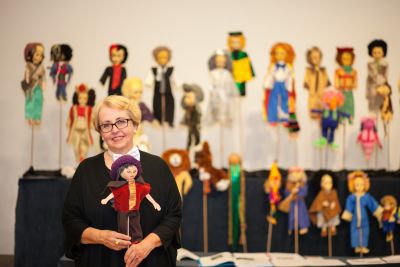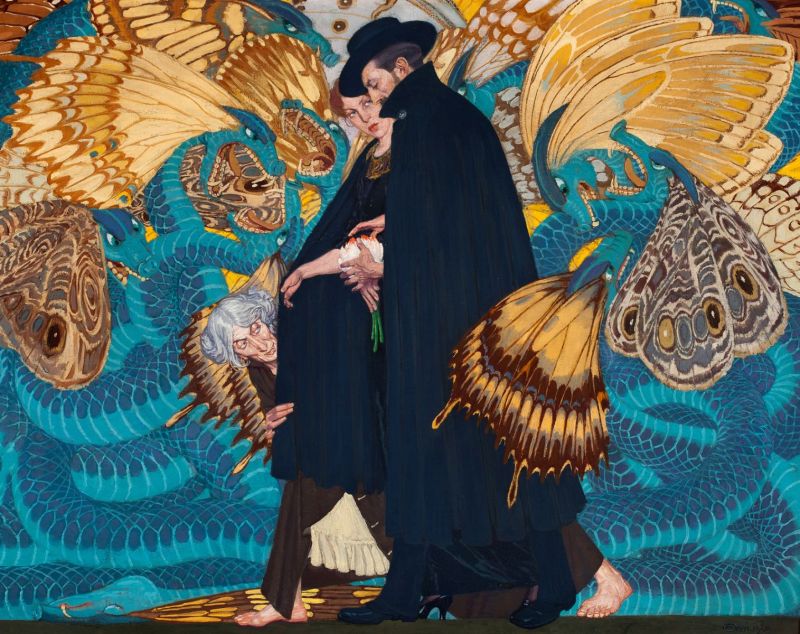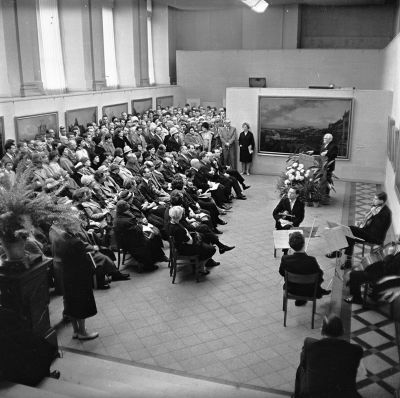Were they really “rebels”? The Munich exhibition “Silent Rebels. Polish Symbolism around 1900”
Mediathek Sorted


































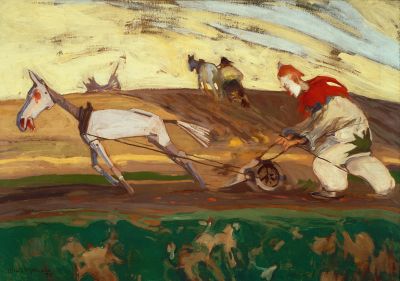


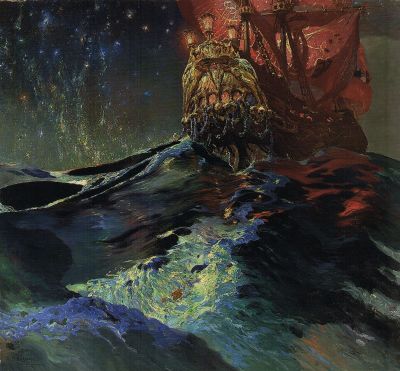
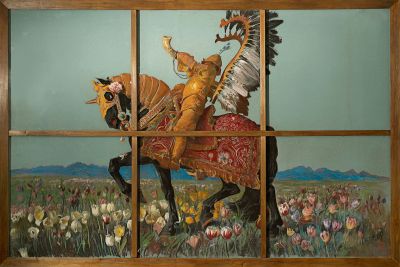



Charazińska names Malczewski, Mehoffer and Wyspiański, who studied under Matejko in Kraków, as being typical representatives of Polish Symbolism, while Tetmajer, also a pupil of Matejko, and Axentowicz with their colourful weddings, processions and harvest festivals in idyllic landscapes demonstrated their solidarity with the Polish country folk, investing them with heroic-mythological features: “The emotive gravity of rural rituals and festivals was seen to reflect the world order, and there was praise for the Polish village landscape as a domain of the blessed, the lost Paradise.” They were followed by the Lviv(/Lemberg/Lwów)-based artists Władysław Jarocki and Kazimierz Sichulski.[19] Ruszczyc and Krzyżanowski “led the beholder ‘into the interior’ of a landscape”, in which emptiness predominated, and in which one could feel “loneliness, a sense of being lost, fear, even horror”. According to Charazińska, they expressed “the existential fears of the people of their age” in a metaphorical way through their landscape paintings.[20] Overall, Charazińska identified four groups of artists: those for whom a significant proportion of their work could be ascribed to Impressionism or Symbolism; those who as “Young Poles” could not be assigned to either of the two groups; and those who added new themes to the canon already explored by Symbolism.
The “Silent Rebels” exhibition in Munich builds on the previous exhibitions in Detroit and Baden-Baden, both in terms of the selection of the artworks shown and the comparative images in the catalogue texts. It also draws on subsequent exhibitions in Raleigh and Chicago in 1993, in Rapperswil in 1996, in Brussels in 2001, in Madrid in 2003, in Dublin in 2007–2008 and finally in Gothenburg in 2018. Conceptually, however, the show aims to go a step further by dividing the works according to their thematic areas, rather than historically or according to the individual artists. In the introduction to the catalogue, however, Albert Godetzky and Nerina Santorius explain that the most important aim of the exhibition is to “familiarise the German public with the subject”, since “Polish art remains relatively unknown among the general population in Germany”.[21]
It therefore comes as a surprise that the subtitle, “Polish Symbolism around 1900”, which is used to describe the temporally and thematically broad epoch from Chełmoński’s “Indian Summer” of 1875 (Fig. 7 
The first section of the exhibition, with the catalogue text “Obligation and Freedom”, and the less trenchant exhibition room texts, “Serious Fools” (room 1) and “The Art Centres Kraków and Warsaw”[24] (room 2, Fig. 4 ) initially document the state of Polish painting between 1862 and 1875 with its most important protagonists, Jan Matejko in Kraków and Wojciech Gerson in Warsaw. In the exhibition, these artists are already described as “silent rebels”, whose art was a non-violent protest against the occupying powers of Prussia, Russia and Austria, and who could be regarded as defending and upholding Polish culture.[25] In Kraków, where Matejko had worked as Director of the School of Fine Arts (Szkoła Sztuk Pięknych) since 1873, and from 1875 as the head of the faculty of art at the School for the Higher Women’s Arts (Wyższe kursy dla kobiet), “the policies of the Austrian authorities were less repressive, as a result of which the city had a certain degree of autonomy and better opportunities for developing an artistic infrastructure”, according to Agnieska Bagińska in the catalogue essay on the topic.[26] Against the background of the Polish poesy of the Romantic period, and of the aspirations in art theory during the decades that followed, Matejko understood his historical paintings – in which he dramatically re-created scenes from 16th and 17th century Polish history filled with a large number of human figures and in a monumental format – as being his obligation towards his homeland and its society. He “repeatedly [stressed] the connection between creativity and patriotic feelings”, and regarded himself as a “prophet and teacher of the nation”.[27] He even did so to the extent that in his paintings, he brought together historical figures who had never come into contact with each other in real life, and positioned selected Polish aristocrats in such a way that they could be identified as traitors to the fatherland. In his view, the purpose of historical painting was to interpret the subjects of the works from a present-day perspective, even if this resulted in criticism of the artist by the aristocratic families.
Was the “painter prince” Matejko, who had comfortably settled with his family into his parent’s house, which was located in the old town of Kraków and which had been modernised and ornately refurbished, already a “rebel” merely by way of his art? He and his wife enjoyed a gentrified existence among the upper echelons of society in the city and had their children pose for portraits in aristocratic costume. In 1878, Matejko was presented with a sceptre, which had previously been blessed by the bishop, in the council chamber of the city hall in front of his 4x10-metre historical painting “The Battle of Grunwald”, as “a symbol of his dominance in the sphere of art”[28]. In 1880, he received Emperor Franz Joseph of Austria in his home and presented the monarch with a painting he had completed the previous year, “Meeting of Jagiellonians with Emperor Maximilian at Vienna”. In 1867, Matejko was awarded the Knight’s Cross of the Order of Franz Joseph, and in 1887 the Pro litteris et artibus medal of the imperial house of Austria. Thousands of people came to pay their respects at his funeral procession on 1 November 1893. As the Vienna weekly newspaper “Das interessante Blatt” wrote, they bore him to the grave “with true regal honours, since he was a prince of art and in addition a real, true Pole, who bore the ideals of freedom of his people in his soul, who never forgot that he was a son of the land that deems itself the unhappiest on Earth”.[29]
[19] Ibid., page 25
[20] Ibid., page 33 f.
[21] Albert Godetzky/Nerina Santorius: Introduction, in: exhibition catalogue, Stille Rebellen 2022, page 14; list of previous exhibitions in comments 2 to 5 in the same publication
[22] Elżbieta Charazińska 1997 (see note 15), page 27
[23] Godetzky/Santorius (see note 21), page 14
[24] All the exhibition room texts are available as part of the online tour: https://www.kunsthalle-muc.de/en/silent-rebels-digital/.
[25] This is one of the curators of the Munich exhibition, Nerina Santorius, a curator at the Kunsthalle München, in an interview with the online portal culture.pl: “Tytuł wystawy można czytać na kilku poziomach. Cicha rebelia to pozbawiony przemocy protest przeciwko okupantom poprzez sztukę, obrona i kultywowanie polskiej kultury, ale także bunt nowego pokolenia artystów Młodej Polski przeciwko akademickiemu malarstwu historycznemu reprezentowanemu przez Jana Matejkę i Wojciecha Gersona, kwestionowanie patriotycznych zobowiązań artysty połączone z pragnieniem artystycznej wolności.” (Agnieszka Bagińska, Nerina Santorius: Docenić lokalne odcienie symbolizmu [wywiad], https://culture.pl/pl/artykul/agnieszka-baginska-nerina-santorius-docenic-lokalne-odcienie-symbolizmu-wywiad)
[26] Agnieszka Bagińska: Pflicht und Freiheit, in: “Stille Rebellen” exhibition catalogue, 2022, page 24
[27] Ibid., page 25
[28] Matejko-Feier, in: Die Presse, Vienna, 31/10/1878, page 10, online resource: https://anno.onb.ac.at/cgi-content/anno?aid=apr&datum=18781031&seite=10&zoom=33
[29] Das Leichenbegängniß Jan Matjko’s in Krakau, in: Das interessante Blatt, Vol. XII., No. 47, Vienna, 23/11/1893, page 4 f.; online resource: https://anno.onb.ac.at/cgi-content/anno?aid=dib&datum=18931123&seite=4&zoom=33

